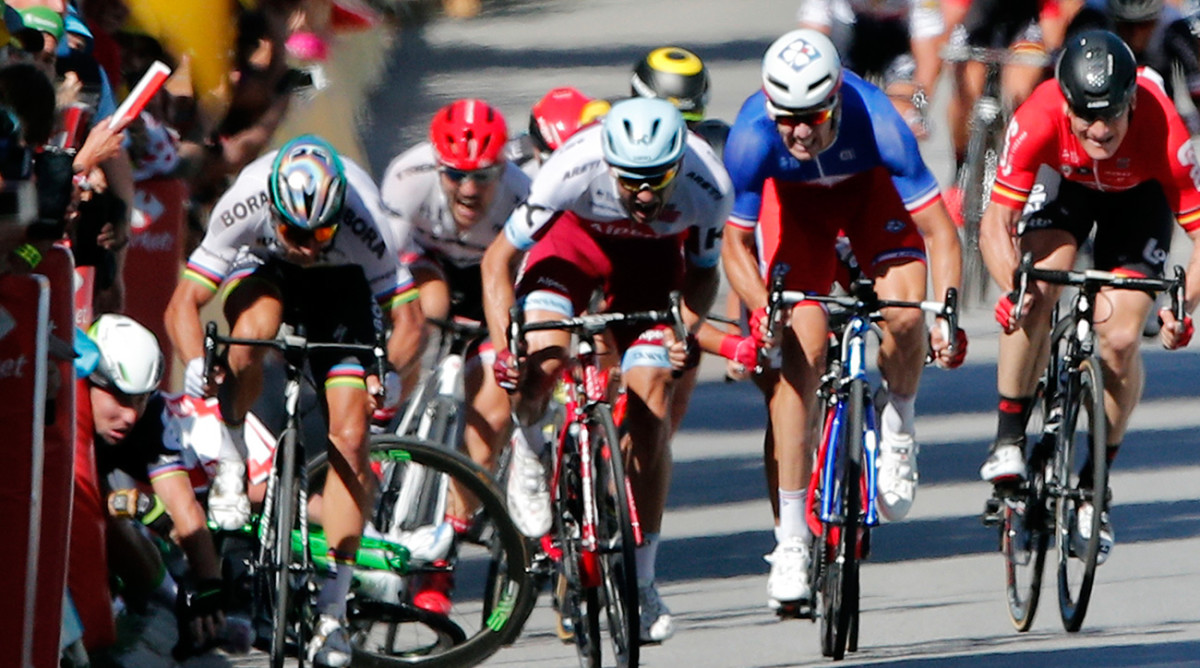
Sometimes video review only makes things worse
This story appears in the July 17, 2017, issue of SPORTS ILLUSTRATED. To subscribe, click here.
If the camera never lies, how come we can't always believe it? Take, for example, SaganGate.
According to the official Tour de France narrative, on July 4, a couple of hundred meters from the finish line of Stage 4, green jersey favorite Peter Sagan, of Slovakia, elbowed sprinter Mark Cavendish, of Great Britain, slamming Cavendish into a roadside barrier. Cavendish broke his shoulder and cut his hand, forcing him to pull out of the race. Sagan was subsequently disqualified by the UCI, cycling's governing body, after a closed-door meeting that reportedly included a video review.
But cycling fans conducted their own frame-by-frame analysis, and what they saw seemed to tell a different story. Wind the tape back a few frames, and Cavendish appears to make the first contact, leaning into Sagan. Zoom in on the apparent elbow strike itself, and Sagan seems to be lifting his arm out of the way of the gear shifter on Cavendish's handlebar. By that point Cavendish's bike already appears to be falling sideways. The video casts doubt on whether Sagan did anything wrong and whether the UCI should have ruled against him.
BORA-hansgrohe, Sagan's team, lodged a protest that was predictably unsuccessful—there is no way to appeal a decision under UCI rules. On July 5, Sagan headed home. "I can accept the decision, but for sure I do not agree with it," he said in a statement. "I have done nothing wrong." (BORA-hansgrohe tried again to get Sagan reinstated days later by appealing to the Court of Arbitration for Sport, but the CAS rejected the case.)
The Internet, of course, ran with the story the way the Internet does. There were conspiracy theories—South African IT services company Dimension Data is both an official partner of the Tour de France and the title sponsor of Cavendish's team—and then abuse and threats targeted Cavendish on social media (though Sagan and Cavendish have both stressed they hold no ill will toward each other). And of course there were memes.
Video evidence is supposed to make sports better, to bring clarity to those moments that confound the human eye. Yet somehow video often seems to make things cloudier. Sometimes the angle isn't quite right, or the key action takes place in the gap between frames. In an April 2014 game against the Red Sox, then Yankees catcher Francisco Cervelli was called safe after a review, although none of the video angles seemed to show his foot touching first base before the throw arrived. Boston manager John Farrell exploded and was ejected from the game.
Other times obvious missed calls are allowed to stand because the play in question is not reviewable. Even more annoying, an official occasionally seems to get the call wrong after looking at video. Last season, in a game against the Panthers, a pass by Cardinals quarterback Carson Palmer was ruled a fumble and returned for a touchdown, despite replays showing the play was a forward pass.
Failure of digital oversight extends outside sports of course, from Big Brother video surveillance to selfies and vlogs we willingly upload to Instagram, Snapchat and Facebook. According to a Pew Research Center survey from November, 77% of Americans own smartphones. That translates to more than 240 million devices. Smile, you're always on camera.
Ubiquitous recording doesn't appear to make us safer. Studies of closed-circuit television footage in the U.K. have shown mixed effectiveness in decreasing crime, and according to the Chicago Tribune, over a six-year span from 2006 to '13, Chicago's 22,000 surveillance cameras helped solve less than 0.05% of the city's million-plus serious crimes. And what you share online—or what others share about you—can have unwanted repercussions.
The 2017 Tour de France is poorer without both Cavendish, who has won 30 individual stages in his career and took the green jersey (worn by the points leader) in 2011, and Sagan, who has eight stage wins and had held the green jersey since 2012. After suffering his injuries, Cavendish's absence was inescapable. But Sagan's expulsion is another example of why we are losing faith in video's ability to help us get it right.




